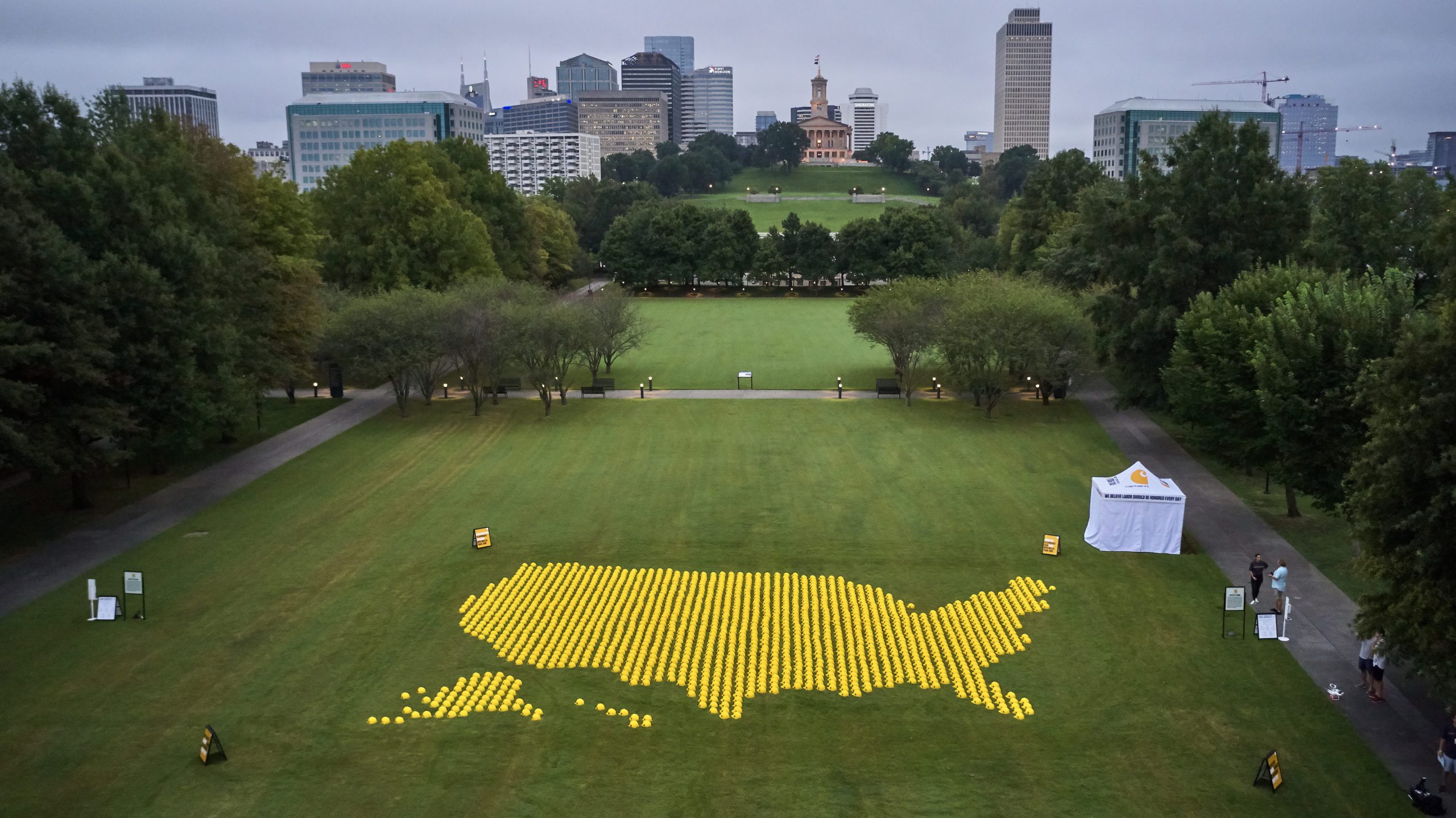
The pandemic changed a lot of things, but as it has receded, Carhartt’s leadership has refocused the company on its main mission: providing high-quality, rugged, specially designed occupational ware, made in the United States, for hard-working Americans – and supporting them in other ways as well.
That’s why the Dearborn, Michigan-based manufacturer and marketer once again on Labor Day honored America’s skilled-trades workers who wear a lot of Carhartt apparel on the job. The company donated not only profits, but all proceeds from a 12-hour period on Labor Day to SkillsUSA, a not-for-profit and long-time partner with Carhartt that helps thousands of American students find career paths in the skilled trades each year. The gift amounted to nearly $317,000.
Carhartt also produced a new online video ad, “Every Day is Labor Day,” that called out skilled tradespeople for special praise in keeping America running and growing. And Carhartt unveiled a larger-than-life installation of 1,670 hard hats in a park in Nashville, in the shape of the United States, to represent the 1.67 million job openings in the skilled trades that remain, even after the pandemic.
“We’re about hard-working people, and there isn’t a better weekend than Labor Day to celebrate that,” Linda Hubbard, president and chief operating officer of Carhartt, told Chief Executive.
Carhartt is still active on the skilled-trades issue because, despite the pandemic, Hubbard believes all of the lost input and creativity in the form of vacant jobs is holding back American productivity — and the economic recovery from Covid-19. “There are still many more thousands leaving the skilled trades every year, especially in the form of retirements, than there are enough young workers to replace them,” Hubbard said. “That’s still a critical shortage.”
Carhartt also is sticking to its pre-Covid-19 strategy in other important ways. The company did pivot immediately to making personal protective equipment amid the initial onrush of the virus. “We did it just as a response to the need,” Hubbard said. “There’s very little apparel manufacturing and sewing left in the United States, so we heard it as a call to action. And we had associates saying they wanted to do this to help.”
But since then, Carhartt has gotten back to its knitting. “We concluded that it’s best to get back to making the core products that we have significant demand for,” Hubbard said.
Carhartt also has been executing a diversification that it began before the pandemic, into providing outfits for company uniform programs. For instance, last year Carhartt co-created a uniform for “below-the-wing” employees of United Airlines, which included warmth technology for frigid winter days on the tarmac and unique pockets for the instruments they carry. “Yes, we delivered all of them prior to Covid-19,” Hubbard said. “I feel terrible for that company.”
Its pandemic experience also led Carhartt to reaffirm a sourcing strategy that it recently decoupled from China for the most part, after the Trump administration’s new tariffs on Chinese-made goods. The company manufacturers its wares at plants in Tennessee and Kentucky, as well as Mexico, but sources materials from 20 countries.
The pandemic “confirmed that what we want to do is continue to have some dual sourcing of our most significant products,” Hubbard said. “There are always concerns around the world.” Carhartt also will continue to devote significant manufacturing capacity to inventory replenishment, she said, an advantage that became more apparent during the supply crimping by Covid-19 disruptions.

Chief Executive Group exists to improve the performance of U.S. CEOs, senior executives and public-company directors, helping you grow your companies, build your communities and strengthen society. Learn more at chiefexecutivegroup.com.
0

1:00 - 5:00 pm
Over 70% of Executives Surveyed Agree: Many Strategic Planning Efforts Lack Systematic Approach Tips for Enhancing Your Strategic Planning Process
Executives expressed frustration with their current strategic planning process. Issues include:
Steve Rutan and Denise Harrison have put together an afternoon workshop that will provide the tools you need to address these concerns. They have worked with hundreds of executives to develop a systematic approach that will enable your team to make better decisions during strategic planning. Steve and Denise will walk you through exercises for prioritizing your lists and steps that will reset and reinvigorate your process. This will be a hands-on workshop that will enable you to think about your business as you use the tools that are being presented. If you are ready for a Strategic Planning tune-up, select this workshop in your registration form. The additional fee of $695 will be added to your total.

2:00 - 5:00 pm
Female leaders face the same issues all leaders do, but they often face additional challenges too. In this peer session, we will facilitate a discussion of best practices and how to overcome common barriers to help women leaders be more effective within and outside their organizations.
Limited space available.

10:30 - 5:00 pm
General’s Retreat at Hermitage Golf Course
Sponsored by UBS
General’s Retreat, built in 1986 with architect Gary Roger Baird, has been voted the “Best Golf Course in Nashville” and is a “must play” when visiting the Nashville, Tennessee area. With the beautiful setting along the Cumberland River, golfers of all capabilities will thoroughly enjoy the golf, scenery and hospitality.
The golf outing fee includes transportation to and from the hotel, greens/cart fees, use of practice facilities, and boxed lunch. The bus will leave the hotel at 10:30 am for a noon shotgun start and return to the hotel after the cocktail reception following the completion of the round.